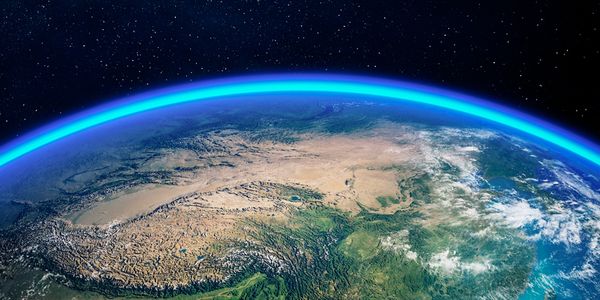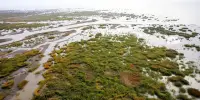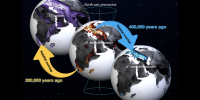New research demonstrates that powerful monsoon winds, aided by a warming climate, are propelling unusually large amounts of ozone-depleting compounds high into the atmosphere over East Asia.
The study, led by the National Science Foundation National Center for Atmospheric Research (NSF NCAR) and NASA, discovered that the East Asian Monsoon transports more than twice as much very short-lived ozone-depleting substances into the upper troposphere and lower stratosphere as previously thought.
The research team relied on aircraft observations collected during a major 2022 Asian field campaign known as the Asian Summer Monsoon Chemistry and Climate Impact Project (ACCLIP). The findings call into doubt the rate at which the ozone layer, which protects the Earth from the Sun’s harmful UV radiation, is recovering.
“It was a real surprise to fly through a plume with all those very short-lived ozone-depleting substances,” said NSF NCAR scientist Laura Pan, the lead author of the study. “These chemicals may have a significant impact on what will happen with the ozone layer, and it’s critical to quantify them.”
The study was published in the Proceedings of the National Academy of Sciences. It was funded by NSF, NASA, and NOAA, and co-authored by a large team of international scientists.
It was a real surprise to fly through a plume with all those very short-lived ozone-depleting substances. These chemicals may have a significant impact on what will happen with the ozone layer, and it’s critical to quantify them.
Laura Pan
The role of monsoons
For thousands of years, humans have valued the Asian summer monsoon due to its effects on local populations. Scientists examining satellite data have recently discovered that monsoon storms and winds also play a role in transporting pollutants high into the atmosphere, where they can influence the global climate system.
ACCLIP studied the chemical composition of the air carried by the region’s two principal monsoons, the South and East Asian Monsoons, from the Earth’s surface to the stratosphere. Once at that level, the chemicals can have far-reaching climate effects because air in the stratosphere spreads out globally and lingers for months to years, as opposed to the lower atmosphere, where air masses change regularly.
The ACCLIP observations revealed that the East Asian Monsoon delivered higher levels of pollutants to the upper atmosphere than the South Asian Monsoon during 2022. The scientists measured carbon monoxide levels of up to 320 parts per billion — a remarkably high level to be found at an altitude of 15 kilometers (about 9 miles). Carbon monoxide is often a sign of industrial pollution, and the measurements indicated that the East Asian Monsoon was closely aligned with emissions of pollutants at the surface.

Pan, Elliot Atlas of the University of Miami, and their co-authors investigated a class of chemicals known as very short-lived organic chlorine compounds, which can degrade ozone but only exist in the environment for a few months to years. In contrast, ozone-depleting chlorofluorocarbons (CFCs) persist in the atmosphere for decades, if not centuries, and are thus regarded as a significantly greater threat to the ozone layer.
As a result, the historic 1987 Montreal Protocol on Substances that Deplete the Ozone Layer aimed to phase out CFCs and other long-lived compounds. The international pact and later adjustments allowed stratospheric ozone to begin to rebound. A 2022 United Nations assessment concluded that the ozone layer, including an ozone hole over the Antarctic, will be largely restored over the next several decades.
However, the Montreal Protocol does not prevent the continued production and use of very short-lived ozone-depleting chemicals. These chemicals’ emissions have skyrocketed across South and East Asia, particularly in highly industrialized parts of East China. Unfortunately, those places are directly beneath the East Asian Monsoon, which is the strongest of the world’s eight regional monsoons and is expected to strengthen the most as a result of global warming.
The monsoon’s intense updrafts, along with increased emissions of short-lived chlorine compounds, have resulted in an unusually large amount of the chemicals being whisked into the stratosphere.
The analysis of the aircraft measurements by Pan and her co-authors revealed high levels of five short-lived chlorine compounds: dichloromethane (CH2Cl2), chloroform (CHCl3), 1,2-dichloroethane (C2H4Cl2), tetrachloroethene (C2Cl4), and 1,2-dichloropropane (C3H6Cl2).
Pan said more research is needed to analyze the potential implications for ozone recovery. The paper also notes that scientists will need to incorporate the new findings into climate models, as stratospheric ozone has complex effects on Earth’s temperature.
“These new observations are important for identifying that the East Asian Monsoon is a significant pathway for large amounts of pollution to rise from the surface to the stratosphere,” said Pan. “Although we expected to see pollution impact in the region, the number of very short-lived ozone-depleting compounds we saw was quite surprising. The possible effects of large quantities of these compounds will need to be considered when projecting both stratospheric ozone recovery and climate change.”
















